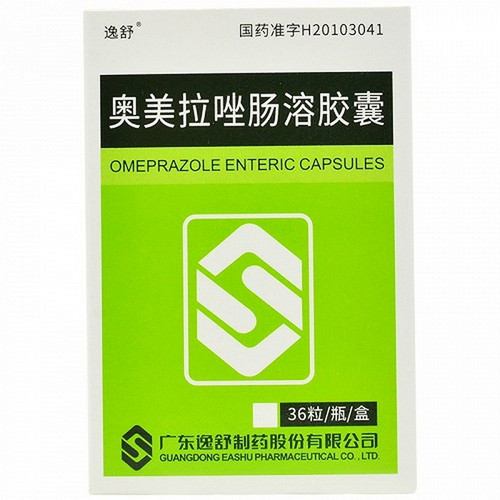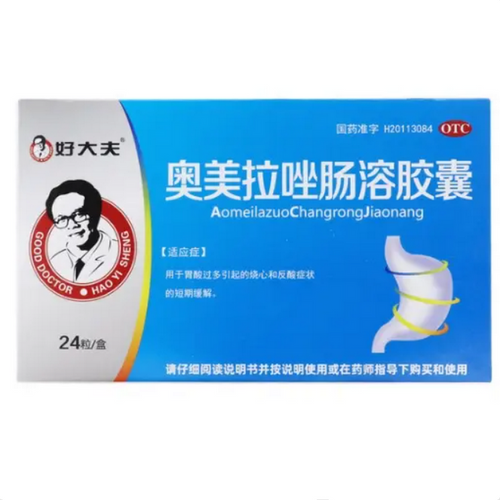Product Overview
[Drug Name]
Generic Name: Omeprazole Enteric-Coated Capsules
Trade Name: Shengyuan Omeprazole Enteric-Coated Capsules 0.25g x 30 Tablets
Pinyin Code: ShengYuan AoMeiLaZuoChangRongJiaoNang
[Main Ingredient]
The main ingredient of this product is omeprazole. Chemical Name: 5-Methoxy-2-{(4-methoxy-3,5-dimethyl-2-pyridyl)-methyl]-sulfinyl}-1H-benzimidazole sodium salt. Molecular Formula: C₁ₐH₁₉N₃O₃S. Molecular Weight: 367.42
[Properties]
This product consists of white or off-white enteric-coated pellets or granules.
[Indications/Main Functions]
It is indicated for gastric ulcers, duodenal ulcers, stress ulcers, reflux esophagitis, and Zollinger-Ellison syndrome (gastrinoma).
[Specifications]
0.25g*30 tablets (Shengyuan)
[Dosage and Administration]
Oral administration, do not chew. 1. Peptic ulcer: 20mg (1 tablet at a time), 1-2 times daily. Swallow in the morning or once in the morning and evening. The treatment course for gastric ulcers is usually 4-8 weeks, and for duodenal ulcers is usually 2-4 weeks. 2. Reflux esophagitis: 20-60mg (1-3 tablets at a time), 1-2 times daily. Swallow in the morning or once in the morning and evening. The treatment course is usually 4-8 weeks. 3. Zollinger-Ellison syndrome: 60mg (3 tablets at a time), once daily. The total daily dose can be adjusted to 20-120mg (1-6 tablets) depending on the condition. If the total daily dose exceeds 80mg (4 tablets), it should be taken in two divided doses.
[Adverse Reactions]
This product is well tolerated. Common adverse reactions include diarrhea, headache, nausea, abdominal pain, flatulence, and constipation. Rarely, elevated serum aminotransferases (ALT, AST), rash, dizziness, drowsiness, and insomnia may occur. These adverse reactions are generally mild, resolve spontaneously, and are unrelated to dose. No serious adverse reactions have been observed with long-term treatment, but gastric mucosal cell hyperplasia and atrophic gastritis may occur in some cases.
[Contraindications]
This product is contraindicated in patients with allergies, severe renal insufficiency, and infants.
[Drug Interactions]
This product may delay the elimination of drugs metabolized by the liver, such as diazepam, phenytoin, warfarin, and nifedipine. When used with these drugs, the dosage of the latter should be reduced.
[Precautions]
1. When treating gastric ulcers, the possibility of ulcerative gastric cancer should be ruled out first, as this product may alleviate symptoms and delay treatment. 2. Use with caution in patients with hepatic and renal insufficiency. 3. This product comes in enteric-coated capsules. Be careful not to chew them when taking to prevent premature release of the drug in the stomach, which could affect efficacy.
[Pediatric Use]
There is no experience with its use in children. It is contraindicated in infants and young children.
[Elderly Use]
Unknown.
[Overdose]
Unknown.
[Pharmacology and Toxicology]
Proton pump inhibitor. This product is a lipid-soluble, weakly alkaline drug that is easily concentrated in acidic environments. Therefore, after oral administration, it is specifically distributed in the secretory tubules of the gastric mucosal parietal cells. In this highly acidic environment, it is converted to its active form, the sulfenamide. It then irreversibly binds to the sulfhydryl group of the H+,K+-ATPase (also known as the proton pump) in the parietal cell secretory membrane via a disulfide bond, forming a sulfenamide-proton pump complex. This complex inhibits the enzyme's activity and blocks the final step in gastric acid secretion. Therefore, this product has a strong and long-lasting inhibitory effect on gastric acid secretion caused by various reasons.









